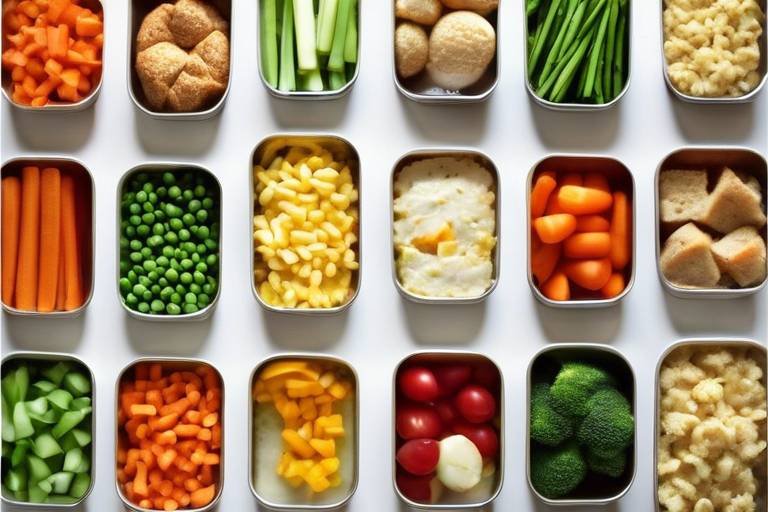Healthy Desserts - Satisfy Your Family's Sweet Tooth the Right Way
Are you tired of feeling guilty every time you indulge in dessert? Well, it's time to turn that frown upside down! Healthy desserts are here to save the day, allowing you to satisfy your family's sweet tooth without compromising on health. Imagine a world where you can enjoy decadent treats that are not only delicious but also packed with nutrients. Sounds dreamy, right? In this article, we'll explore a range of healthy dessert options that will keep your loved ones happy and their bodies nourished. So, grab a spoon and get ready to dive into the delicious world of healthy sweets!
So, what exactly are healthy desserts? At their core, healthy desserts are those that provide a balance of taste and nutrition. They often incorporate wholesome ingredients that are lower in sugar, higher in fiber, and rich in vitamins and minerals. Think of them as the superheroes of the dessert world—delicious and beneficial! By choosing healthier options, you can help your family manage their sugar intake while still enjoying the sweet flavors they crave. Plus, these desserts can be a great way to sneak in extra fruits, veggies, and whole grains into your diet.
One of the easiest ways to create healthy desserts is by making simple ingredient substitutions. You don’t have to sacrifice flavor or texture; instead, you can swap out traditional ingredients for healthier alternatives. For instance, instead of using white flour, consider using almond flour or oat flour. Not only do these options add a unique flavor, but they also provide more nutrients. Similarly, replacing refined sugars with natural sweeteners can make a world of difference. Let’s explore these substitutions further!
When it comes to sweetening your desserts, natural sweeteners like honey, maple syrup, and stevia are fantastic alternatives to refined sugar. These options not only add sweetness but also come with their own set of health benefits. For example, honey is known for its antioxidant properties, while maple syrup contains essential minerals like manganese and zinc. By using these natural sweeteners, you can enhance the flavor of your desserts while reducing the overall sugar content, making your treats both tasty and guilt-free!
Did you know that fruits can be a fantastic natural sweetener? Incorporating fruits like bananas, applesauce, or dates into your recipes can add sweetness and moisture without the need for added sugars. For instance, mashed bananas can replace sugar in muffins, while applesauce can be used in cakes. Not only do these fruits provide natural sweetness, but they also come packed with vitamins and fiber. So, the next time you're baking, reach for the fruit bowl instead of the sugar jar!
Choosing whole grains over refined grains can significantly improve the health profile of your desserts. Whole grains retain their bran and germ, which are rich in fiber and essential nutrients. In contrast, refined grains have been stripped of these components, making them less nutritious. Consider using whole wheat flour, oats, or quinoa in your dessert recipes. Not only will this increase the fiber content, but it will also keep your family feeling fuller for longer. It's a win-win!
If you have family members who are lactose intolerant or simply prefer plant-based options, dairy alternatives can be a game-changer in your dessert-making. Options like almond milk, coconut yogurt, and cashew cream can seamlessly replace traditional dairy products without sacrificing flavor. For instance, using coconut milk in a pudding recipe can add a rich, creamy texture while keeping it dairy-free. Your desserts can be inclusive and delicious, ensuring everyone at the table can indulge!
Now that we've covered the essentials of healthy ingredients, let’s get creative! Here are a few recipes that showcase the deliciousness of healthy desserts:
Fruit-based desserts are not only refreshing but also incredibly nutritious. Think of a mixed berry parfait layered with Greek yogurt and topped with a sprinkle of granola. Or how about a chocolate avocado mousse? It sounds unusual, but the avocado provides a creamy texture while being packed with healthy fats. These desserts highlight the natural sweetness of fruits while keeping things light and satisfying!
No-bake desserts are perfect for those hot summer days when you want something sweet but don’t want to turn on the oven. Consider making energy bites using oats, nut butter, and a touch of honey. Simply mix, roll into balls, and refrigerate! Or try a no-bake cheesecake made with cashew cream and fresh fruit. These recipes require minimal effort and are sure to impress your family!
Q: Are healthy desserts really satisfying?
A: Absolutely! Healthy desserts can be just as satisfying as traditional ones. They often use natural sweeteners and wholesome ingredients that enhance flavor and texture.
Q: Can I make healthy desserts without special ingredients?
A: Yes! Many healthy dessert recipes use common pantry staples. You can create delicious treats with ingredients you likely already have at home.
Q: How can I get my kids to eat healthy desserts?
A: Get creative! Involve them in the cooking process and let them choose the fruits or flavors. Making it a fun activity can encourage them to try new things.

Understanding Healthy Desserts
When it comes to desserts, the word “healthy” often conjures up images of bland, tasteless treats that leave you yearning for the real deal. But let me tell you, healthy desserts can be both satisfying and delicious! The secret lies in understanding what makes a dessert healthy and how to incorporate nutritious ingredients without sacrificing flavor. So, what exactly defines a healthy dessert? Generally, a healthy dessert is lower in refined sugars and unhealthy fats, while being rich in nutrients, fiber, and whole ingredients.
Choosing healthier options for your family’s sweet cravings not only satisfies their sweet tooth but also comes with a plethora of benefits. For instance, opting for desserts made with whole ingredients can help improve digestion, boost energy levels, and even enhance mood. Imagine enjoying a dessert that not only tastes good but also nourishes your body! It’s like having your cake and eating it too, right?
One of the key aspects of healthy desserts is the balance of flavors. You don’t need to drown your treats in sugar to make them delicious. Instead, consider using natural sweeteners and incorporating fruits to enhance flavor. Additionally, using whole grains instead of refined ones can elevate the nutritional profile of your desserts, making them a guilt-free indulgence.
Another important factor is portion control. Just because a dessert is healthy doesn't mean you should go overboard. Moderation is key! By understanding your ingredients and making mindful choices, you can create treats that are not only tasty but also align with a healthy lifestyle.
In summary, healthy desserts are all about making smart choices without compromising on taste. They can be a fantastic way to indulge your family’s sweet cravings while keeping their health in check. So, the next time you’re tempted to reach for that sugary treat, consider whipping up something healthy instead. Your taste buds—and your body—will thank you!

Ingredient Substitutions
When it comes to creating healthy desserts, ingredient substitutions play a crucial role. You don’t have to sacrifice flavor or texture to make your family’s favorite treats healthier. In fact, with a few simple swaps, you can transform traditional recipes into guilt-free delights that everyone will love. Imagine being able to indulge your sweet tooth while also nourishing your body! It’s not just a dream; it’s entirely achievable with the right choices.
One of the first things to consider is the type of sweetener you use. Instead of reaching for refined sugar, which can spike blood sugar levels and provide empty calories, consider using natural sweeteners. These alternatives not only add sweetness but also come packed with their own health benefits. For instance, honey, maple syrup, and stevia can enhance the flavor of your desserts while reducing the overall sugar content. Not only do they taste great, but they also offer some additional nutrients that refined sugar lacks.
Another fantastic way to sweeten your desserts is by incorporating fruits. Fruits are nature's candy, bursting with flavor and natural sugars. Think about using mashed bananas in your muffins or pureed dates in your brownies. Not only do these fruits add sweetness, but they also contribute moisture and nutrients, making your desserts even more wholesome. For example, a simple banana bread can be elevated by substituting sugar with ripe bananas, creating a moist and delicious treat that your family will devour.
When it comes to the base of your desserts, consider the difference between whole grains and refined grains. Whole grains, such as oats, whole wheat flour, and brown rice flour, provide more fiber and nutrients than their refined counterparts. This means your family will feel fuller longer and benefit from the vitamins and minerals that whole grains offer. You can easily swap out all-purpose flour for whole wheat flour in recipes like cookies and cakes without sacrificing taste. In fact, many people find that whole grain desserts have a deeper, nuttier flavor that enhances the overall experience.
Dairy alternatives are another area where you can easily make substitutions. If you have family members who are lactose intolerant or simply looking to reduce dairy intake, there are plenty of options available. Almond milk, coconut yogurt, and cashew cream can be used in place of regular milk and cream in your dessert recipes. These alternatives not only cater to dietary restrictions but also add unique flavors and textures to your treats. For instance, using coconut cream in a pie can create a rich and creamy filling that rivals traditional recipes.
In conclusion, making ingredient substitutions is a powerful way to create healthy desserts without compromising on taste. By choosing natural sweeteners, incorporating fruits, opting for whole grains, and using dairy alternatives, you can whip up delicious treats that your family will love. So why not give it a try? You might just find that your new favorite dessert is a healthier version of an old classic!
- Can I use honey instead of sugar in any recipe?
Yes, honey can be used as a substitute for sugar, but it’s important to adjust the liquid content in the recipe since honey is a liquid sweetener. - What are some good dairy alternatives for baking?
Almond milk, coconut milk, and oat milk are excellent dairy alternatives that work well in most baking recipes. - How do I know if a recipe can be made healthier?
Look for opportunities to swap out refined sugars, use whole grains, and incorporate fruits or natural sweeteners.

Natural Sweeteners
When it comes to satisfying your sweet tooth, can be a game changer. Unlike refined sugars, which can spike your blood sugar and leave you crashing later, natural sweeteners offer a more balanced approach to sweetness. They not only enhance the flavor of your desserts but also come packed with additional nutrients. So, what are some of the best options out there? Let's dive into a few popular choices.
First up, we have honey. This golden nectar is not just a sweet treat; it’s also rich in antioxidants and has antibacterial properties. Using honey in your desserts can add a unique flavor profile while also providing health benefits. Just remember, honey is sweeter than sugar, so you might need less of it. For instance, if a recipe calls for one cup of sugar, you can substitute it with about two-thirds of a cup of honey.
Next on our list is maple syrup. This delicious syrup not only brings a delightful taste but is also a great source of minerals such as manganese and zinc. It works wonderfully in baked goods, and a little goes a long way. Plus, who can resist the warm, comforting flavor of maple? Just like honey, it’s sweeter than regular sugar, so adjust accordingly.
Then we have stevia, a plant-based sweetener that’s gaining popularity for its zero-calorie count. Derived from the leaves of the Stevia rebaudiana plant, it’s significantly sweeter than sugar. This makes it an excellent option for those looking to cut back on calories without sacrificing sweetness. However, be cautious with the quantity, as its intense sweetness means you’ll need much less than you would with sugar.
Incorporating these natural sweeteners into your cooking and baking can be a fun experiment. You might be surprised by how well they work in your favorite recipes! For example, consider the following table that compares these sweeteners:
| Sweetener | Calories (per tablespoon) | Sweetness Level | Health Benefits |
|---|---|---|---|
| Honey | 64 | 1.5 times sweeter than sugar | Rich in antioxidants, antibacterial properties |
| Maple Syrup | 52 | 1.3 times sweeter than sugar | Contains minerals, antioxidants |
| Stevia | 0 | 50-300 times sweeter than sugar | Zero calories, may help regulate blood sugar |
As you can see, natural sweeteners not only provide a healthier alternative but also add unique flavors to your desserts. So next time you're whipping up a treat for your family, consider swapping out that refined sugar for one of these delicious options. Your taste buds—and your body—will thank you!

Fruits as Sweeteners
When it comes to sweetening your desserts, fruits are nature's candy! Not only do they bring a burst of flavor, but they also pack a nutritional punch that refined sugars simply can't match. Imagine biting into a luscious slice of cake that’s sweetened with ripe bananas or a creamy pudding made with fresh mangoes. It's like having your cake and eating it too, without the guilt! By incorporating fruits into your desserts, you can enhance the sweetness while also adding fiber, vitamins, and antioxidants.
One of the most exciting aspects of using fruits as sweeteners is the variety available. Each fruit has its unique flavor profile, allowing you to experiment and discover new favorites. For instance, applesauce can replace sugar in many recipes, lending moisture and sweetness without the added calories. Similarly, dates, when blended into a paste, can create a rich, caramel-like sweetness that’s perfect for brownies or energy balls. Not to mention, fruits like berries can be pureed and used in sauces or toppings, adding not just sweetness but also vibrant color to your desserts.
Here are a few fruits that work wonders as sweeteners:
- Bananas: Their natural sweetness makes them perfect for smoothies, muffins, and pancakes.
- Dates: A fantastic substitute for refined sugar, especially in energy bites and brownies.
- Applesauce: Great for baking, adding moisture and sweetness to cakes and cookies.
- Mangoes: Their rich flavor can enhance puddings and sorbets.
Moreover, using fruits not only sweetens your desserts but also adds natural flavors that are often more complex and enjoyable than artificial sweeteners. This is especially true for tropical fruits like pineapple and coconut, which can transport your taste buds to a sunny paradise. So, next time you’re whipping up a dessert, consider reaching for that bowl of fresh fruit instead of the sugar jar. Your body will thank you, and your family will love the delicious results!
Q: Can I use frozen fruits as sweeteners?
A: Absolutely! Frozen fruits can be just as effective as fresh ones. Just make sure to thaw them and drain any excess liquid before using them in your recipes.
Q: Are there any fruits that are better for baking?
A: Yes! Bananas, applesauce, and pureed dates work particularly well in baking due to their moisture content and natural sweetness. They can help keep your baked goods soft and delicious.
Q: How do I know how much fruit to use as a sweetener?
A: It often depends on the recipe, but a good rule of thumb is to start with half the amount of fruit as a substitute for sugar and adjust to taste. Remember, the ripeness of the fruit can also affect its sweetness!

Whole Grains vs. Refined Grains
When it comes to making healthier choices in our diets, understanding the difference between whole grains and refined grains is crucial. Whole grains are grains that contain all three parts of the grain kernel: the bran, germ, and endosperm. This means they retain their natural nutrients, providing a rich source of fiber, vitamins, and minerals. On the other hand, refined grains have been processed to remove the bran and germ, which strips away much of their nutritional value. Think of whole grains as the whole package, while refined grains are like a gift box that's been emptied of its most valuable contents.
Choosing whole grains over refined grains can significantly enhance the health profile of your desserts. For instance, whole grains can help regulate blood sugar levels, improve digestion, and reduce the risk of chronic diseases. When you opt for desserts made with whole grains, you're not just indulging your sweet tooth; you're also providing your body with essential nutrients that it craves.
To illustrate the differences, here's a simple comparison table:
| Aspect | Whole Grains | Refined Grains |
|---|---|---|
| Nutritional Content | High in fiber, vitamins, and minerals | Lower in nutrients due to processing |
| Health Benefits | Supports digestion, heart health, and weight management | May contribute to weight gain and blood sugar spikes |
| Common Sources | Brown rice, quinoa, whole wheat flour, oats | White rice, white bread, pastries |
Incorporating whole grains into your dessert recipes can be as simple as swapping out white flour for whole wheat flour or using oats as a base for cookies and bars. Not only does this add a delightful texture, but it also boosts the nutritional value of your treats. Imagine biting into a cookie that not only satisfies your sweet cravings but also offers a hearty dose of fiber and nutrients. It's like getting the best of both worlds!
So, next time you're whipping up a dessert, consider reaching for whole grains. Your taste buds and your body will thank you. Remember, making small changes can lead to big health benefits over time. By choosing whole grains, you’re not only nourishing yourself but also setting a positive example for your family, showing them that healthy eating can be both delicious and satisfying.

Dairy Alternatives
When it comes to satisfying a sweet tooth, dairy can often play a starring role in many dessert recipes. However, for those who are lactose intolerant, vegan, or simply looking to cut back on dairy for health reasons, there are plenty of that can step in without sacrificing flavor or texture. Imagine whipping up a creamy dessert that tastes just as good as the original, but is made with ingredients that are kinder to your digestive system and overall health.
One of the most popular dairy substitutes is almond milk. This nut-based milk has a subtle sweetness and creamy texture that works wonderfully in puddings, cakes, and even ice creams. It’s low in calories and packed with vitamin E, making it a fantastic choice for a health-conscious family. Another excellent option is coconut milk, which brings a rich, tropical flavor to desserts. Whether you're making a decadent mousse or a light sorbet, coconut milk can add that creamy touch without any dairy.
For those who miss the richness of traditional creams, cashew cream can be a game-changer. Soaked cashews blended with a bit of water create a smooth, creamy texture that can easily replace heavy cream in recipes. This alternative not only provides a luxurious mouthfeel but is also a great source of healthy fats. You might even be surprised at how well it can mimic the taste and consistency of dairy cream in your favorite desserts!
Let’s not forget about yogurt! There are countless dairy-free yogurts available made from almond, coconut, or soy bases. These can serve as a perfect base for parfaits or frozen desserts. They often contain probiotics, which are beneficial for gut health, adding an extra layer of nutrition to your sweet treats.
To help you navigate the world of dairy alternatives, here’s a quick comparison of some popular options:
| Dairy Alternative | Flavor Profile | Best Used In |
|---|---|---|
| Almond Milk | Nutty, slightly sweet | Puddings, cakes, smoothies |
| Coconut Milk | Rich, tropical | Mousses, sorbets, ice creams |
| Cashew Cream | Rich, creamy | Creamy desserts, sauces |
| Dairy-Free Yogurt | Varies by base (almond, coconut, soy) | Parfaits, frozen desserts |
Incorporating these dairy alternatives into your dessert repertoire not only opens up a world of flavors but also ensures that everyone can indulge in sweet treats without worrying about dietary restrictions. So next time you’re craving something sweet, consider reaching for one of these alternatives. You might just find that you prefer the new twist on a classic dessert!
Q: Can I use dairy alternatives in all dessert recipes?
A: Most desserts can be adapted to use dairy alternatives, but it's essential to consider the specific recipe and adjust the ratios for optimal texture and taste.
Q: Are dairy alternatives healthier than regular dairy?
A: Many dairy alternatives are lower in calories and fat, and they often contain beneficial nutrients, but it's important to check labels for added sugars and preservatives.
Q: What is the best dairy alternative for baking?
A: Almond milk and coconut milk tend to work well in baking, but cashew cream can also provide a rich texture in recipes that require cream.

Creative Healthy Dessert Recipes
When it comes to satisfying that sweet tooth, who says you have to sacrifice health for flavor? With a little creativity, you can whip up delicious healthy desserts that will have your family begging for seconds. Let’s dive into some innovative recipes that are not only easy to prepare but also packed with nutrients. You’ll be amazed at how simple ingredients can come together to create mouthwatering treats that everyone will enjoy!
One fantastic option is the Chia Seed Pudding. This dessert is not only visually appealing but also incredibly nutritious. Chia seeds are rich in omega-3 fatty acids, fiber, and protein. To make this treat, simply mix 1/4 cup of chia seeds with 1 cup of almond milk (or any dairy alternative), add a drizzle of honey or maple syrup for sweetness, and let it sit in the fridge overnight. In the morning, top it with your favorite fruits and nuts for an extra crunch!
Another crowd-pleaser is the Banana Oatmeal Cookies. These cookies are a fantastic way to use up ripe bananas while avoiding refined sugars. You’ll need:
- 2 ripe bananas
- 1 cup of rolled oats
- 1/2 cup of dark chocolate chips (optional)
Simply mash the bananas, mix in the oats and chocolate chips, and bake at 350°F (175°C) for about 15 minutes. The result? Soft, chewy cookies that are naturally sweet and perfect for a guilt-free snack!
If you’re looking for a refreshing treat, how about some Fruit Sorbet? This dessert is a breeze to make and can be customized with any fruit you love. Just blend your chosen fruit with a bit of honey and lemon juice, pour it into a container, and freeze it for a few hours. The best part? You can use fruits like mango, berries, or even watermelon to create a vibrant, flavorful sorbet that’s sure to impress.
For those who love a bit of crunch, try making Nutty Energy Bites. These little powerhouses are perfect for an afternoon pick-me-up. Combine 1 cup of mixed nuts, 1 cup of dates, and a tablespoon of cocoa powder in a food processor. Roll the mixture into small balls and refrigerate. Not only are they easy to make, but they’re also a great source of healthy fats and energy!
Lastly, let’s not forget about Greek Yogurt Parfaits. Layer Greek yogurt with granola and your choice of fresh fruits for a dessert that’s both satisfying and nutritious. Not only is Greek yogurt packed with protein, but it also serves as a creamy base that pairs perfectly with crunchy granola and sweet fruit. You can even drizzle a little honey on top for added sweetness!
Incorporating these creative healthy dessert recipes into your family’s routine can transform the way you think about sweets. Not only do they satisfy cravings, but they also provide essential nutrients that contribute to overall health. So, next time you’re in the kitchen, don’t hesitate to experiment with these delightful options – your taste buds and your family will thank you!
1. Are healthy desserts really satisfying?
Absolutely! Healthy desserts can be just as satisfying as traditional ones, especially when they are made with natural ingredients that enhance flavor and texture.
2. Can I substitute ingredients in my favorite dessert recipes?
Yes! Many traditional dessert recipes can be easily modified by using healthier alternatives such as whole grains, natural sweeteners, and dairy substitutes.
3. How can I make desserts more nutritious?
Incorporate fruits, nuts, and whole grains into your recipes. These ingredients not only add flavor but also boost the nutritional value of your desserts.
4. Are there any no-bake healthy dessert options?
Definitely! Many healthy desserts can be made without baking, such as chia seed puddings, energy bites, and no-bake cheesecakes.
5. How can I encourage my family to try healthy desserts?
Make it fun! Involve your family in the preparation process, and let them choose their favorite fruits or toppings. Presenting healthy desserts in an appealing way can also make them more enticing.

Fruit-Based Desserts
When it comes to healthy desserts, fruit-based options are like the superheroes of the sweet world! They not only satisfy your cravings but also pack a punch of vitamins and minerals. Imagine biting into a juicy peach cobbler or savoring a rich banana bread—these treats can be both delicious and nutritious. The beauty of fruit-based desserts lies in their versatility; they can be enjoyed all year round, adapting to whatever fruits are in season.
One of the simplest ways to create a fruit-based dessert is by using fresh fruits. Think about a vibrant mixed berry parfait layered with yogurt and granola. It’s not just visually appealing; it also provides a wonderful crunch and a creamy texture that will make your taste buds dance. You can experiment with different combinations, like sliced strawberries with a dash of balsamic vinegar for an unexpected twist. The sweetness of the strawberries combined with the tanginess of the vinegar creates a flavor explosion that’s hard to resist!
Another fantastic option is fruit sorbet. This refreshing treat is incredibly easy to make at home. All you need is your favorite fruit, a bit of natural sweetener, and a blender. For example, a mango sorbet made with ripe mangoes, a splash of lime juice, and a drizzle of honey can transport you straight to a tropical paradise. Plus, it’s dairy-free, making it perfect for those who are lactose intolerant.
Let’s not forget about baked fruit desserts, which can be a delightful way to enjoy the natural sweetness of fruits. A classic apple crisp made with whole oats and a sprinkle of cinnamon can warm your heart and home. The combination of baked apples, crunchy topping, and a scoop of dairy-free ice cream can create a comforting dessert that feels indulgent without the guilt. You can easily swap in different fruits like pears or peaches, depending on what you have on hand.
For a more adventurous take, consider making fruit skewers. These colorful creations are perfect for gatherings or family nights. Simply thread chunks of pineapple, strawberries, and kiwi onto skewers, and grill them for a few minutes. The heat caramelizes the sugars, enhancing their natural sweetness, and you can serve them with a drizzle of dark chocolate for an added touch of decadence. It’s like a party on a stick!
Incorporating fruits into your desserts not only elevates the flavor but also boosts the nutritional value. Fruits provide dietary fiber, which aids digestion, and they are often lower in calories than traditional dessert ingredients. So, the next time you're craving something sweet, reach for the fruits! You’ll be amazed at how satisfying and delicious they can be.
- Can I use frozen fruits for desserts? Absolutely! Frozen fruits are just as nutritious as fresh and can be used in many recipes.
- Are fruit-based desserts suitable for children? Yes! They are a great way to introduce children to healthier sweet options.
- What fruits are best for baking? Apples, bananas, and berries are fantastic choices for baking due to their natural sweetness and moisture content.

No-Bake Options
If you’re looking for a way to satisfy your family’s sweet tooth without turning on the oven, no-bake desserts are your best friend! These delightful treats are not only easy to whip up, but they also save you from the heat of the kitchen, making them perfect for warm days or when you're short on time. Imagine a dessert that requires minimal effort yet delivers maximum flavor—sounds like a dream, right?
No-bake desserts come in various forms, from creamy cheesecakes to crunchy energy bars. The beauty of these options is that they often utilize ingredients that are already wholesome and nutritious. For instance, many no-bake recipes rely on nuts, seeds, and dried fruits as their base, providing a rich source of healthy fats, fiber, and essential nutrients. By combining these ingredients with natural sweeteners, you can create a dessert that is both delicious and guilt-free.
One of the most popular no-bake treats is the energy ball. They're incredibly versatile, allowing you to mix and match ingredients based on what you have on hand. You can use oats, nut butter, honey, and a variety of add-ins like chocolate chips or shredded coconut. Just roll them into bite-sized balls, chill them in the fridge, and you have a perfect snack that doubles as a dessert!
Another fantastic option is no-bake cheesecake. By using cream cheese or a dairy alternative blended with natural sweeteners and topped with fresh fruits, you can create a dessert that's both rich and refreshing. The best part? You don’t need to worry about baking times or temperatures—just mix, pour, and chill! Here’s a quick overview of a simple no-bake cheesecake recipe:
| Ingredients | Quantity |
|---|---|
| Cream Cheese (or dairy-free alternative) | 8 oz |
| Natural Sweetener (like honey or maple syrup) | 1/3 cup |
| Vanilla Extract | 1 tsp |
| Graham Cracker Crumbs (or nut crust) | 1 cup |
| Butter (or coconut oil) | 1/4 cup |
To make it, simply mix the cream cheese, sweetener, and vanilla until smooth. Meanwhile, combine the graham cracker crumbs with melted butter to form the crust. Press the crust into a pan, pour the cheesecake filling on top, and let it chill for a few hours. Top it off with fresh fruit, and you have a stunning dessert that will impress everyone!
Finally, don't forget about no-bake cookies. These little bites are made by combining oats, nut butter, cocoa powder, and a sweetener of your choice. They require no baking, just a bit of stirring and chilling. They’re perfect for those moments when you want something sweet but don’t want to spend a lot of time in the kitchen.
In conclusion, no-bake desserts are a fantastic way to indulge your family’s sweet cravings while keeping things simple and healthy. With so many options available, you can easily find a recipe that fits your taste and dietary needs. So next time you’re in the mood for something sweet, remember that you can create delicious desserts without ever turning on the oven!
- Are no-bake desserts healthy? Yes, many no-bake desserts can be made with wholesome ingredients, making them a healthier alternative to traditional baked goods.
- How long do no-bake desserts last? Most no-bake desserts can be stored in the refrigerator for up to a week, but it's always best to check individual recipes for specific storage guidelines.
- Can I freeze no-bake desserts? Absolutely! Many no-bake desserts freeze well, allowing you to prepare them in advance and enjoy them later.
Frequently Asked Questions
- What defines a healthy dessert?
A healthy dessert is typically lower in refined sugars and unhealthy fats while being rich in nutrients. These desserts often incorporate whole ingredients, such as fruits, whole grains, and natural sweeteners, allowing you to indulge without the guilt.
- Can I use regular sugar in healthy dessert recipes?
While you can use regular sugar, it's better to opt for natural sweeteners like honey, maple syrup, or stevia. These alternatives can enhance flavor and provide additional health benefits, making your desserts more nutritious.
- Are there dairy alternatives for desserts?
Absolutely! There are numerous dairy alternatives available, such as almond milk, coconut milk, and cashew cream. These substitutes can help you create delicious desserts that cater to lactose-intolerant family members without compromising on taste.
- How can I incorporate fruits into my desserts?
Fruits can be used in various ways, such as purees, chunks, or dried forms. You can blend bananas into smoothies, use applesauce in baked goods, or top your desserts with fresh berries for added sweetness and nutrition.
- What are some easy no-bake dessert options?
No-bake desserts are fantastic for quick and easy indulgence! Some popular options include energy balls, yogurt parfaits, and chilled fruit tarts. These treats often require minimal prep and can be whipped up in no time!
- How do whole grains improve the health profile of desserts?
Whole grains are packed with fiber, vitamins, and minerals compared to refined grains. By using whole grain flour or oats in your desserts, you boost their nutritional value while adding a delightful texture and flavor.
- Can I make healthy desserts ahead of time?
Yes! Many healthy desserts can be made in advance and stored in the fridge or freezer. This not only saves time but also allows the flavors to meld together, making them even more delicious when you're ready to enjoy them.



















